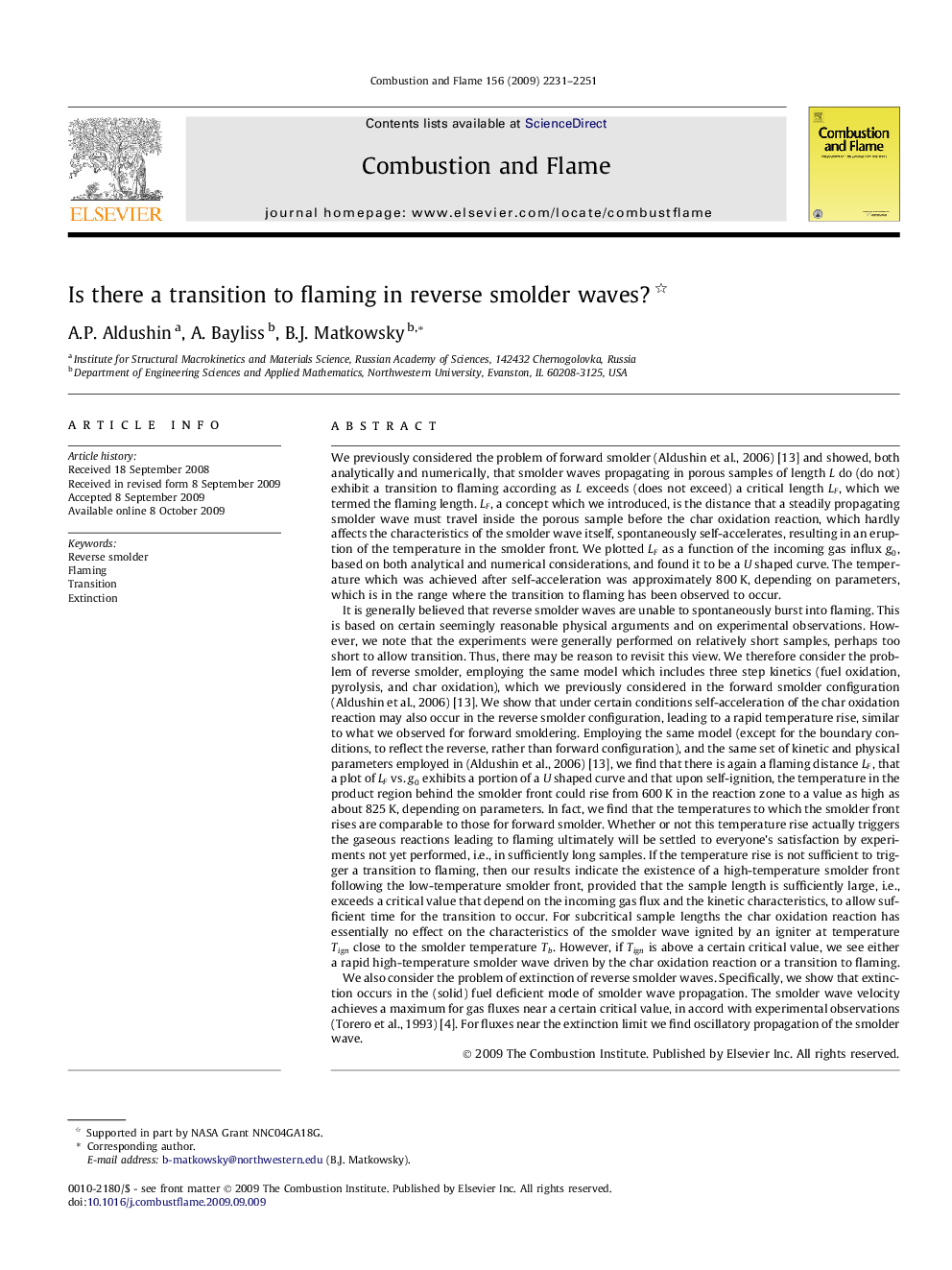| کد مقاله | کد نشریه | سال انتشار | مقاله انگلیسی | نسخه تمام متن |
|---|---|---|---|---|
| 169442 | 458005 | 2009 | 21 صفحه PDF | دانلود رایگان |

We previously considered the problem of forward smolder (Aldushin et al., 2006) [13] and showed, both analytically and numerically, that smolder waves propagating in porous samples of length L do (do not) exhibit a transition to flaming according as L exceeds (does not exceed) a critical length LFLF, which we termed the flaming length. LFLF, a concept which we introduced, is the distance that a steadily propagating smolder wave must travel inside the porous sample before the char oxidation reaction, which hardly affects the characteristics of the smolder wave itself, spontaneously self-accelerates, resulting in an eruption of the temperature in the smolder front. We plotted LFLF as a function of the incoming gas influx g0g0, based on both analytical and numerical considerations, and found it to be a U shaped curve. The temperature which was achieved after self-acceleration was approximately 800 K, depending on parameters, which is in the range where the transition to flaming has been observed to occur.It is generally believed that reverse smolder waves are unable to spontaneously burst into flaming. This is based on certain seemingly reasonable physical arguments and on experimental observations. However, we note that the experiments were generally performed on relatively short samples, perhaps too short to allow transition. Thus, there may be reason to revisit this view. We therefore consider the problem of reverse smolder, employing the same model which includes three step kinetics (fuel oxidation, pyrolysis, and char oxidation), which we previously considered in the forward smolder configuration (Aldushin et al., 2006) [13]. We show that under certain conditions self-acceleration of the char oxidation reaction may also occur in the reverse smolder configuration, leading to a rapid temperature rise, similar to what we observed for forward smoldering. Employing the same model (except for the boundary conditions, to reflect the reverse, rather than forward configuration), and the same set of kinetic and physical parameters employed in (Aldushin et al., 2006) [13], we find that there is again a flaming distance LFLF, that a plot of LFLF vs. g0g0 exhibits a portion of a U shaped curve and that upon self-ignition, the temperature in the product region behind the smolder front could rise from 600 K in the reaction zone to a value as high as about 825 K, depending on parameters. In fact, we find that the temperatures to which the smolder front rises are comparable to those for forward smolder. Whether or not this temperature rise actually triggers the gaseous reactions leading to flaming ultimately will be settled to everyone’s satisfaction by experiments not yet performed, i.e., in sufficiently long samples. If the temperature rise is not sufficient to trigger a transition to flaming, then our results indicate the existence of a high-temperature smolder front following the low-temperature smolder front, provided that the sample length is sufficiently large, i.e., exceeds a critical value that depend on the incoming gas flux and the kinetic characteristics, to allow sufficient time for the transition to occur. For subcritical sample lengths the char oxidation reaction has essentially no effect on the characteristics of the smolder wave ignited by an igniter at temperature TignTign close to the smolder temperature TbTb. However, if TignTign is above a certain critical value, we see either a rapid high-temperature smolder wave driven by the char oxidation reaction or a transition to flaming.We also consider the problem of extinction of reverse smolder waves. Specifically, we show that extinction occurs in the (solid) fuel deficient mode of smolder wave propagation. The smolder wave velocity achieves a maximum for gas fluxes near a certain critical value, in accord with experimental observations (Torero et al., 1993) [4]. For fluxes near the extinction limit we find oscillatory propagation of the smolder wave.
Journal: Combustion and Flame - Volume 156, Issue 12, December 2009, Pages 2231–2251